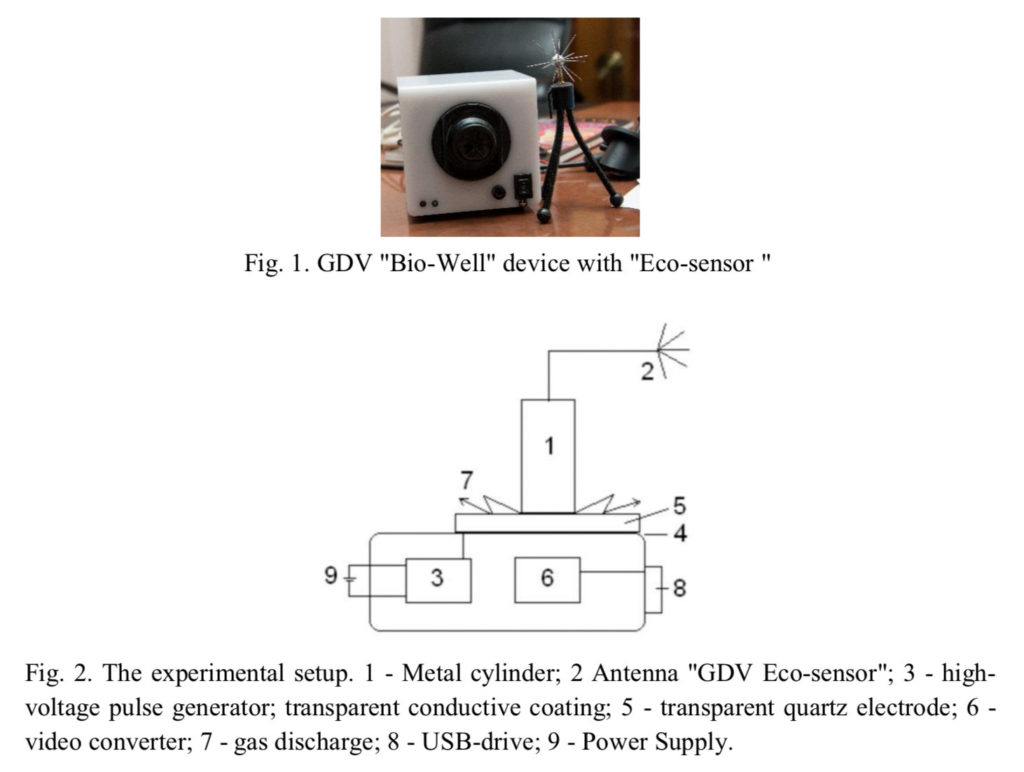EXPERIMENTAL APPROACH TO STUDY MIND-MATTER INTERACTIONS
Konstantin G. Korotkov1, Dmitry. V. Orlov1, and Pradeep B. Deshpande2
1St. Petersburg State University of Information Technologies, Mechanics and Optics
2Professor Emeritus of Chemical Engineering, University of Louisville and President and CEO, Six Sigma and Advanced Controls, Inc.
Abstract
Physical principles and experimental results of application of the Gas Discharge Visualization system (GDV) in conjunction with a “GDV Eco-sensor” special antenna which allows the monitoring both of non-selective characteristics of the environment and the functional state, in particular emotional state, of groups of people, are presented. The method was tested during theater performances and concerts, workshops and lectures, as well as in group meditation. In many cases, the correlation of GDV parameters variations and emotional state of the audience was recorded. The lowest values of the standard deviation of a signal corresponded to quiet functional state of people. Accordingly, the larger the standard deviation, the higher functional stress of people in the room. The system presented has two sensitive elements: antenna “GDV Eco-sensor” and the gas discharge itself, which makes it non-selectively sensitive to changes in chemical and physical characteristics of the surrounding space. The challenge was to develop a methodology and a low-cost device for informative, comprehensive evaluation of the consciousness interaction with the physical reality, which can be used both in a professional environment and by the civilian population.
Key words: Quantum theory of mind and consciousness, mind-matter interactions, emotions, meditation, environment.
MIND-MATTER INTERACTIONS STUDY Introduction
Objective of this paper is presenting physical principles and experimental results of application of the Gas Discharge Visualization system (GDV) in conjunction with a “GDV Eco-sensor” special antenna, which allows to study different aspects of mind-matter interactions.
One of the key questions of the consciousness study is the following: is consciousness a property of the individual mind solely governing activity of a person, or is it expanding into the environment, having the property to influence other people and physical reality? To answer this question we need both to develop conceptual ideas explaining consciousness from the modern scientific paradigm, and create new experimental approaches. The most potential conceptual ideas was offered by quantum theories of mind and consciousness. The original motivation in the early 20th century for relating quantum theory to consciousness was essentially philosophical [1]. Quantum theory introduced an element of randomness standing out against the previous deterministic worldview. Other features of quantum theory, which were found attractive in discussing issues of consciousness, were the concepts of complementarity and entanglement. In particular, relations between the two can be conceived in terms of dual aspects of one underlying “reality”. This conception, drawing on the philosophy of Spinoza, has been considered attractive by 20th century scientists such as Bohr, Pauli, Bohm, Primas, d’Espagnat, and others. There are quite a number of accounts discussing quantum theory to consider intentional conscious acts as intrinsically correlated with physical state reductions. Another idea dating back to Ricciardi and Umezawa in the 1960s is to treat mental states, particularly memory states, in terms of vacuum states of quantum fields [2]. A prominent proponent of this approach at present is Vitiello [3]. Several other ideas trying to explain different aspects of consciousness was developed by different research groups [4,5].
Experimental approach to study interactions of consciousness with the environment and, in particular, with different physical sensors was developed by many research groups in the last century (survey of different results may be found in [6] ). Many experiments in this field were conducted in Russia [7], China [8] and Japan [9]. At the same time, scientific community still keeps very skeptical attitude to all experimental evidences of the consciousness influence to the physical reality.
A complex set of parameters of the bio-sphere and techno-sphere determines the ecological state of the environment and its influence on the health and well-being of people. These include among many factors the features and climate of the area, particularly, level of solarization, level of air pollution, and distribution of electromagnetic fields of natural and anthropogenic origin. Recent research has shown that a significant contribution is also made by the heterogeneity of the earth’s crust structure as discontinuous zones of tectonic disturbances and tensions, in particular, ancient buried rivers10,11 . During 1992-2005 a large scientific team took a number of geological, geochemical, geographical and ecological surveys in St. Petersburg, looking for correlations between them and the health status of the population. The investigation revealed a statistically significant correlation between the level of disease in different areas of St. Petersburg and the presence of underground anomalies12. The influence of the electromagnetic field on human health has been widely studied13, including the effect of artificial electromagnetic radiation on the overall balance of the Earth’s own microwave radiation and the response of biological systems to perturbations of the electromagnetic field in the high frequency (HF) and very high frequency (VHF) bands through human activities14. The variety of factors and their dynamic nature requires the use of complex specialized methods which are not always available even in well-equipped research centers. This makes the evaluation of hazards difficult even for large companies, not to mention individual citizens. A similar assessment is important both at the design phase of new construction and in the analysis of the causes of poor health and the increased incidence of poor health in certain climatic and geographical areas.
The challenge for engineering is therefore is to develop a methodology and a low-cost device for informative, comprehensive evaluation of the consciousness interaction with the physical reality, which can be used both in a professional environment and by the civilian population. As these effects are strongly dependent on the subtle influence of the environmental factors, this device should be sensitive to the integral parameters of the ecological environment.
The purpose of this paper is to show that the GDV technique meets these challenges.
MIND-MATTER INTERACTIONS STUDY Materials and methods.
EPI/GDV Technique. The Human Energy Field (HEF) is a highly sensitive reflection of the physical, emotional, and in some instances, the spiritual assessment of an individual. To measure the energy field, the fingers of both hands are subjected to electrical current one finger at a time for a millisecond the data so obtained is converted into an HEF image using sophisticated proprietary software. This technology is based on the Gas Discharge Visualization (GDV) principle. The results obtained are interpreted on the basis of the energy connections of the fingers with different organs and systems via meridians as in acupuncture and traditional Chinese medicine. The application of computer technology in the processing of electrophysiological information significantly accelerates data-processing time, to standardize the procedure, and to reduce the influence of the subjective factor.
Electro-diagnostic techniques such as Electro-encephalogram and Electro-cardiogram are widely used in medical practices worldwide15. A promising method already utilized in sixty- two countries to great success is Bioelectrography based on the Kirlian effect. This effect occurs when an object is placed on a glass plate and stimulated with current when a visible glow occurs, i. e., a gas discharge. The Kirlian effect is quantifiable with an EPI/GDV electro- photon-imaging-through gaseous-discharge-visualization Bioelectrography camera and is reproducible. The images of all ten fingers on each human subject (BIO-grams) provide detailed information about an individual’s psycho-somatic and physiological state16. The EPI/GDV camera system and the accompanying software is the most effective and reliable instrument in the field of Bioelectrography17,18,19,2021. The application of EPI/GDV in other areas are under development22,23,24,25,26,27,28,29,30.
The fluorescent fingertip images dynamically change with emotional and health states. The investigation of these images identifies the areas of congestion or ill-health in the whole system. Every fingertip photograph is analyzed by sector division, according to acupuncture meridians. Dr. Peter Mandel, in Germany31, and Dr. Voll developed this intricate and well-defined method of seeing into the entire body through the fingertips over many decades. The EPI/GDV researchers have created a diagnostic table based on many years of their own clinical field- testing, the sector basis of which differs slightly from that of Dr Mandel32.
The parameters of the image generated from photographing the finger surface under electrical stimulation creates a neurovascular reaction of the skin which is influenced by the nervous- humoral status of all organs and systems. Thus, the images captured on the EPI/GDV register an ever-changing range of states33. However, for most healthy people the EPI/GDV readings vary only 8-10% over many years of measurements indicating a high level of precision in this technique. A specialized software registers these readings into parameters which elucidate the person’s state of wellbeing at the time of the investigation34.
MIND-MATTER INTERACTIONS STUDY
Monitoring the Environment
The GDV device with a specially designed sensor called the “Eco-sensor antenna” is used to monitor the Energy of the Environment and its effects on the emotional status. The “Eco-sensor antenna” is a specialized Bio-Well device that measures the energy of the environment in a room and may be used to study if and how the energy varies when people meditate, pray or listen to a presentation. The physical principle is based on the measurement of the electrical capacitance of a space by using two connected resonance contours. An image of the GDV device Bio-Well is shown in Figure 1. A schematic representation of the experimental setup is shown in Figure 2.
A 15-mm diameter Titanium cylinder connected to the antenna 2 is positioned on the quartz surface of the electrode 5, the reverse side of which is covered with a transparent conductive coating 4. From the generator 3 every 5 seconds a voltage in the form of a pulse sequence of up to 7 kV amplitude, 10 microsecond duration at a frequency of 1 kHz is applied to the coating. The gas discharge 7, light, is transformed by the optoelectronic system 6 in a series of images, and analyzed in a computer. The outcome files are time-stamped, allows their comparison with the sequence of registered events.
Full text: EXPERIMENTAL APPROACH TO STUDY MIND-MATTER INTERACTIONS
EXPERIMENTAL APPROACH TO STUDY MIND-MATTER INTERACTIONS on IUMAB Library. Welcome to the Biointernet Expeditions! The Energy of Space


